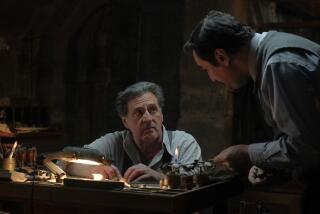U.S. Embassy in Berlin: It’s dull
BARACK OBAMA is planning a visit to the German capital this month -- reportedly to deliver a major foreign-policy speech at Pariser Platz, the stately, almost perfectly proportioned plaza that has emerged since the fall of the Berlin Wall as the heart of reunified Berlin. Forty-five years after John F. Kennedy drew huge crowds for his own press-friendly, image-conscious address in this city, it’s not hard to imagine the rationale running through Obama’s head: I will cross oceans for a suitably statesmanlike photo-op.
Not quite as clear is the choice of backdrop his advisors will make if the speech unfolds as planned. They may simply position their candidate directly in front of the Brandenburg Gate, the imposingly colonnaded entrance to the plaza. But they might also want to allow cameras filming Obama to catch a glimpse of the brand-new American Embassy, which sits adjacent to the gate -- almost literally in its shadow -- and was formally dedicated on July 4.
In certain settings, for certain U.S. candidates, deciding to use one of our embassies as an architectural stage set would be a snap. But unlike the Brandenburg Gate, where Ronald Reagan gave the most famous speech of the Cold War in 1987, the new embassy here is a structure whose symbolic meaning, even as piece of political stagecraft, is neither robust nor clear-cut.
Indeed, the $143-million embassy, designed by the Santa Monica firm Moore Ruble Yudell, is something of an anti-monument -- a five-story, low-slung, sandstone-colored palimpsest on which is inscribed the complicated history of urbanism in Berlin, the troubled state of U.S. embassy design and the pitfalls of slavishly contextual architecture.
MRY, a firm co-founded in 1977 by the much-traveled, much-loved postmodernist Charles Moore and now run by two of his former colleagues, John Ruble and Buzz Yudell, remains dedicated to the less-than-fashionable idea that new buildings should advertise their sensitivity to the architecture surrounding them. It was precisely that trait, in fact, that helped the firm win the Berlin commission a dozen years ago.
By the early 1990s, American and German officials had preliminarily endorsed the idea of building a new U.S. embassy on the location of the old one, which was occupied only briefly before World War II and then heavily damaged during it. The site, squeezed into the southwestern corner of Pariser Platz and down the street from the Reichstag, the seat of German power recently modernized with a glass dome by the British architect Norman Foster, seemed to lend itself to a careful, contextual treatment.
MRY won the embassy job in 1996, beating out a star-studded group of fellow contextualists including Robert A.M. Stern and the husband-and-wife duo Robert Venturi and Denise Scott Brown. It was quite a coup for a firm after Moore’s death three years earlier.
After that, the embassy project got complicated. First, in 1998, came bombings at U.S. embassies in Kenya and Tanzania, leading the State Department to tighten design guidelines already beefed up in response to the 1983 attack on U.S. Marines in Beirut. The updated standards, which remain in place, make building in a tight urban location such as Pariser Platz almost impossible.
For a time, Washington considered putting the new embassy on the outskirts of the city, in a secure compound surrounded by blast-proof walls. The Sept. 11 attacks only strengthened the hand of the government faction pushing for hyper-secure diplomatic architecture; huge new U.S. embassies in Beijing and Baghdad follow the essentially suburban compound model. But enough other politicians -- in Washington and Berlin -- pushed back against that idea to finally make a new U.S. embassy on Pariser Platz a reality.
Harsh reviews
IN 2002, MRY got final word that the project would go forward -- only to learn a year later that the budget was being slashed by roughly 40%, from $121 million to $81 million. Surging materials costs pushed that number back up in the end, but the belt-tightening meant sacrificing some key elements of the initial design proposal. The facade, originally meant to be all stone, has only narrow bands of the material running horizontally. A fully decked-out, western-style lodge was downgraded to a multipurpose room with fireplace.
The finished embassy, which I toured on a highly chaperoned visit with the architects on July 3, has been skewered in the German press as a symbol of Bush-era American muscle. A review in a Frankfurt daily mentioned water-boarding and said the embassy gives a visitor “the impression that he is about to enter the Green Zone in Baghdad.”
But the embassy is hardly a posturing piece of architecture; it is far more thoughtful than militaristic. Its biggest weakness lies in the fact that it gives ground so easily, willing to risk becoming an architectural cipher.
Backpedaling
THE RULING architectural conceit of the design is that a pair of colliding grids are responsible for shaping much of its interior layout. (One grid is aligned with the front of the Brandenburg Gate, the other with Ebertstrasse, the wide boulevard running along the embassy’s western edge.) On the front facade, facing Pariser Platz, a clumsy, wave-like glass canopy hangs over the main entrance. Behind the canopy is a cylindrical rotunda topped by a skylight, which means that the main gesture of the building’s most important elevation is not actually a gesture at all but rather a void. Walking into the building is like shaking hands with a man who is backtracking even as he’s introduced to you.
The building’s longest facade, facing the leafy Tiergarten across Ebertstrasse, continues the retreat: It is pushed back a full 75 feet from the street to guard against car bombs. The setback, though certainly not the architects’ idea, manages to wreck the alignment-of-grids concept before it can begin to succeed as an urban gesture.
On its rear facade, facing Peter Eisenman’s Memorial to the Murdered Jews of Europe, which was completed in 2005, the embassy is even more muted and well-behaved. It looks like a run-of-the-mill office building in a mid-sized American city that happens to share a block with the ghosts of concentration-camp victims.
Inside, the embassy is arranged in the shape of the letter C. A spacious garden in the center, by the landscape architect Laurie Olin, looks a bit bare now but should improve with time. On the top floor, the state room is encased in a second large cylinder to balance the rotunda, this one nearly all glass and offering dramatic views toward the Reichstag. The offices themselves are designed as long, loft-like spaces; light streams through sizable blast-proof windows.
Buildings facing Pariser Platz have to devote a minimum percentage -- roughly 30% -- of their facades to windows. At the same time, the U.S. government won’t allow embassy facades to include much more than that amount of window coverage, because glass is highly vulnerable to bomb blasts and other attacks. The embassy was also subject to strict review by Berlin planning officials; they had a say in the building’s height and proportions and even its color.
Considered as a whole, the embassy is an object lesson in the risks that come with making a fetish of contextualism. Unlike Frank Gehry’s 1999 DZ Bank building immediately next door, in which the contrast between an expressive, even passionate interior and the constraints of building in the center of dense Berlin produce some real sparks, the embassy makes the fatal mistake of stepping back from those constraints as a preemptive, conciliatory gesture.
Think of it this way: MRY designed the embassy from the start to appear constricted by various urban forces. And then, as it traveled its wayward path to completion, it actually was constricted by those forces. If the embassy went through the architectural wringer twice, in other words, the first trip was contrived and unnecessary.
Is it any wonder the final product feels so limply unimpressive?
christopher.hawthorne@latimes.com
More to Read
Sign up for The Wild
We’ll help you find the best places to hike, bike and run, as well as the perfect silent spots for meditation and yoga.
You may occasionally receive promotional content from the Los Angeles Times.






